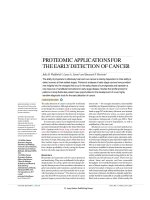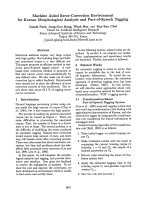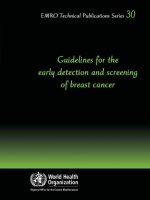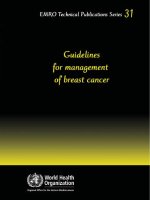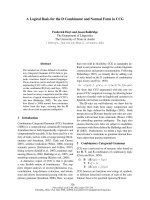Guidelines for the early detection and screening of breast cancer ppt
Bạn đang xem bản rút gọn của tài liệu. Xem và tải ngay bản đầy đủ của tài liệu tại đây (472.9 KB, 57 trang )
EMRO Technical Publications Series 30
Guidelines for the early
detection and screening of
breast cancer
Editors
Oussama M.N. Khatib (MD, PhD, FRCP)
Regional Adviser
Noncommunicable Diseases
WHO Regional Office for the Eastern Mediterranean
Atord Modjtabai
Professor of Pathology
United States of America
© World Health Organization 2006
All rights reserved.
The designations employed and the presentation of the material in this publication do not imply the expression
of any opinion whatsoever on the part of the World Health Organization concerning the legal status of any
country, territory, city or area or of its authorities, or concerning the delimitation of its frontiers or boundaries.
Dotted lines on maps represent approximate border lines for which there may not yet be full agreement.
The mention of specific companies or of certain manufacturers’ products does not imply that they are endorsed
or recommended by the World Health Organization in preference to others of a similar nature that are not
mentioned. Errors and omissions excepted, the names of proprietary products are distinguished by initial
capital letters.
The World Health Organization does not warrant that the information contained in this publication is complete
and correct and shall not be liable for any damages incurred as a result of its use.
The named authors alone are responsible for the views expressed in this publication.
Publications of the World Health Organization can be obtained from Distribution and Sales, World Health
Organization, Regional Office for the Eastern Mediterranean, PO Box 7608, Nasr City, Cairo 11371, Egypt
(tel: +202 670 2535, fax: +202 670 2492; email: ). Requests for permission to reproduce
WHO EMRO publications, in part or in whole, or to translate them – whether for sale or for noncommercial
distribution – should be addressed to the Regional Adviser, Health and Biomedical Information, at the above
address (fax: +202 276 5400; email ).
Cover design and layout by Ahmad Hassanein
Printed by Fikra Advertising Agency
WHO Library Cataloguing in Publication Data
Khatib, Oussama M.N.
Guidelines for the early detection and screening of breast cancer /
Edited by Oussama M.N. Khatib, Atord Modjtabai
p. (EMRO Technical Publications Series ; 30)
1. Breast neoplasms – Diagnosis 2. Breast neoplasms – Prevention and Control
3. Breast neoplasms – Epidemiology I. Modjtabai Atord II. Title III. WHO Regional Office for the
Eastern Mediterranean IV. Series
ISBN : 978-92-9021-406-9 (NLM Classification : WP 870)
ISSN : 1020-0428
Contents
Foreword 5
Preface 7
Acknowledgements 9
Epidemiology of breast cancer 11
Global overview 11
Regional overview 11
International collaboration in breast cancer control 13
Natural history, etiology and risk factors 14
Natural history 14
Etiology 14
Genetic predisposition 14
Hormonal factors 15
Environmental factors 16
Sociobiological factors 16
Physiological factors 17
Pathology of the breast 18
Breast disease 18
Staging 19
Clinical course 20
Managerial aspects of breast cancer detection 21
Managerial approach 21
Surveillance 21
Protection 21
Continuing education 22
Prevention 22
Early detection 22
Care/disease intervention 23
Cancer detection programmes 24
Early detection of cancer 24
Cancer screening 24
Screening for breast cancer 26
Screening approach 26
4 Guidelines for the early detection and screening of breast cancer
Breast self-examination 27
Overview 27
Tactile examination 27
Visual examination 30
Breast self-examination costs 32
Mechanisms for improving breast self-examination 32
Clinical breast examination 33
Overview 33
Clinical breast examination technique 33
Clinical breast examination effectiveness 34
Screening mammography 36
Overview 36
Mammograms 36
Mammography reading 38
Other breast imaging techniques 40
Ultrasonography 40
Computed tomography (CT) 40
Magnetic resonance imaging (MRI) 40
Nuclear medicine breast imaging 40
Positron emission tomographic screening (PET) 41
Guided breast biopsy 41
Breast mass evaluation 41
Follow-up and cost-effectiveness 42
Physical health follow-up 42
Mental health follow-up 42
Cost-effectiveness 43
Organization of screening programmes 44
Evaluation of screening programmes 45
Framework for implementation of the guidelines 46
References 49
Annex 1 Participants in the consultation on early detection and
screening of breast cancer 51
Annex 2 Consensus opinion of the regional task force for developing
breast cancer prevention, screening and management guidelines 52
Foreword
Cancer is an important factor in the global burden of disease. The estimated number
of new cases each year is expected to rise from 10 million in 2002 to 15 million by 2025,
with 60% of those cases occurring in developing countries. Breast cancer is the most
common cancer in women in the Eastern Mediterranean Region and the leading cause
of cancer mortality worldwide. There is geographic variation, with the standardized age-
incidence rate being lower in developing than industrialized countries.
Although the etiology of breast cancer is unknown, numerous risk factors may
influence the development of this disease including genetic, hormonal, environmental,
sociobiological and physiological factors. Over the past few decades, while the risk of
developing breast cancer has increased in both industrialized and developing countries
by 1%–2% annually, the death rate from breast cancer has fallen slightly. Researchers
believe that lifestyle changes and advances in technology, especially in detection and
therapeutic measures, are in part responsible for this decrease.
Breast cancer does not strike an individual alone but the whole family unit. Despite
considerable social changes, women continue to be the focus of family life. The impact
of breast cancer is therefore profound on both the woman diagnosed with the disease and
her family. Their fear and anxiety over the eventual outcome of the illness may manifest
itself through behavioural changes.
The high incidence and mortality rates of breast cancer, as well as the high cost of
treatment and limited resources available, require that it should continue to be a focus
of attention for public health authorities and policy-makers. The costs and benefits of
fighting breast cancer, including the positive impact that early detection and screening
can have, need to be carefully weighed against other competing health needs. Ministry
of Health officials need to formulate and implement plans that will effectively address
the burden of the disease, including setting policies on the early detection and screening
of breast cancer. Health care providers should also be involved in discussion of the
issue and in developing programmes for the management of the disease. I hope these
guidelines will support everyone involved in the battle against breast cancer in the
Eastern Mediterranean Region.
Hussein A. Gezairy MD FRCS
Regional Director for the Eastern Mediterranean
In the Name of God, the Compassionate, the Merciful
Vacat page
Preface
Breast cancer is a major killer of women both globally and regionally. Studies have
shown that most patients with breast cancer in the Region present for the first time at
stages two and three, indicating the need for increased community awareness and early
detection of the disease. This publication aims to assist countries to develop national
breast cancer detection programmes by describing the key elements of such programmes.
It discusses the epidemiology of breast cancer, its natural history and risk factors, and
gives a brief description of various pathological subtypes. A regional overview of the
epidemiological situation in the Eastern Mediterranean Region is also provided.
Cancer is a leading cause of death and disability in the Eastern Mediterranean
Region, and Member States are becoming increasingly aware of the importance of
including cancer control programmes within their national health plans. During the past
few years, development of national cancer control programmes has been a principal
component of national health planning and several of the resolutions of the WHO
Regional Committee for the Eastern Mediterranean have addressed the importance
of cancer control. The Forty-third Session of the Regional Committee recognized the
importance of cancer control in 1996, adopting resolution EM/RC43/R.12 identifying
cancer as a major health problem and calling on Member States to initiate national
programmes for cancer control.
Experience has shown that no matter what resource restraints a country faces, a well
conceived and well managed national cancer control programme is able to lower cancer
incidence and improve the lives of people living with cancer. The function of these
programmes is to evaluate the processes for controlling the disease and to implement those
that are the most cost-effective and beneficial for the general population. Programmes
should promote the development of treatment guidelines and place emphasis on the
prevention and early detection of cancers, while providing as much comfort as possible
to patients with advanced disease.
Breast cancer is a heterogeneous disease in both its biology and clinical manifestations.
Advances in knowledge and progress in the therapy of breast cancer have been based
upon a multidisciplinary approach, which is required for the development of early
detection and screening guidelines as well as the proper treatment and follow-up of
patients. A standardized protocol requires a systematic review of the literature to address
the core questions of who is to benefit from the health intervention, i.e. those at high
risk of early morbidity and mortality, and what health intervention is most appropriate
in terms of efficacy and has been proven to be cost-effective in reducing morbidity and
mortality.
8 Guidelines for the early detection and screening of breast cancer
The Regional Office has been proactive in the development, implementation and
assessment of regional guidelines for the early detection and screening of breast cancer,
and has given special attention to supporting the development of national programmes for
the early detection of breast cancer. The participation of regional experts in the process
of guideline development was recognized as critical to their effective implementation.
The guidelines were prepared by the WHO Regional Office for the Eastern
Mediterranean. The idea was conceived at the Consultation on Early Detection and
Screening of Breast Cancer, held at the Regional Office in Cairo in 2002, during which a
framework for the guidelines was prepared by participants (see Annex 1). In January 2004,
the Task Force for Developing Breast Cancer Prevention, Screening and Management
Guidelines was established at a meeting at the King Faisal Specialist Hospital and
Research Centre in Riyadh, a WHO collaborating centre for cancer prevention and care.
The Task Force suggested directions for development of breast cancer prevention and
screening guidelines which were taken into consideration in developing these guidelines.
(see Annex 2).
These resulting evidence-based guidelines have been designed to support Ministries
of Health in their policy-setting for early detection and screening of breast cancer, as well
as to assist health care providers and patients in decision-making in the most commonly
encountered situations. This publication is accompanied by a quick reference card.
Acknowledgements
The WHO Regional Office for the Eastern Mediterranean acknowledges with
thanks the contributions of the participants at the Regional Consultation on Early
Detection and Screening of Breast Cancer (Annex 1) held in Cairo, Egypt, 21–24
October 2002 whose discussions provided the impetus for this publication. WHO
would like to thank the Task Force for Developing Breast Cancer Prevention, Screening
and Management Guidelines (see Annex 2) for their input to the development of these
guidelines, as well as Adnan Ezzat, Hussein Khaled, Sherif Omar and Taher Al Twegieri
for reviewing the draft publication. Finally, WHO extends special thanks to Anthony B.
Miller for his extensive review of the final draft and substantive contribution, particularly
in developing the framework for implementation of the guidelines.
Vacat page
Epidemiology of breast cancer
Global overview
Breast cancer represents 10% of all cancers diagnosed worldwide annually and
constituted 22% of all new cancers in women in 2000, making it by far the most common
cancer in women. The incidence of breast cancer in women in high-income countries in
2000 was at least twice that of any other cancer, similar to the incidence of cancer of the
cervix in low-income countries. The risk of breast cancer is low in the low-income regions
of sub-Saharan Africa and in Asia, including Japan where the probability of developing
breast cancer by the age of 75 is one third that of other high-income countries.
Clear increases in the incidence of, and mortality from, breast cancer were observed
up to the early 1980s in both high-income and low-income countries. The subsequent
advent of early detection and screening programmes in high-income countries altered
the reported rates of both incidence and mortality, masking trends in the underlying risk
for the disease. Mortality rates for breast cancer in western Europe and North America
are in the order of 15–25 per 100 000 women, being slightly more than a third of the
incidence rate, which is approximately 50–60 per 100 000 [1].
The survival rate from breast cancer in developing countries is generally poorer than
in developed countries, primarily as a result of delayed diagnosis of cases. According to
WHO’s The World Health Report 2000 [2], noncommunicable diseases, including cancer,
account for 75% of all deaths in the Americas, European and Western Pacific Regions,
including China. In contrast, noncommunicable diseases account for half of all deaths
that occur in the South-East Asia and Eastern Mediterranean Regions, and less than 25%
of all deaths that occur in the African Region.
Regional overview
During the past two decades significant demographic changes have taken place
in the Eastern Mediterranean Region. The progressive decline in the crude death
rate, increasing life expectancy, urbanization and changes in lifestyle associated with
economic transition have resulted in an increase in noncommunicable diseases.
There is now sufficient evidence to indicate that cancer is becoming a major health
concern for many countries within the Eastern Mediterranean Region, although there
is considerable variation in the types and incidence of cancers, mostly related to age
distribution, and environmental and lifestyle changes. Among cancers in the female
population of the Region, breast and, in a few countries cervical, cancers lead in the
incidence of mortality and morbidity.
12 Guidelines for the early detection and screening of breast cancer
It is important to have accurate and updated census data on cancer-specific mortality
and incidence. There are no significant data to indicate the incidence of breast cancer
based on geographical distribution, but the age-standardized incidence of breast cancer
is 12–50 per 100 000 women, with the lowest incidence in the Islamic Republic of
Iran and Pakistan. A higher incidence of breast cancer (50/100 000) is seen in Middle
Eastern and North African countries. However, the relative frequency of breast cancer
in the majority of the countries in the Region is between 15% and 25% of all cancers
diagnosed [1] (see Figure 1).
According to the Regional Office database and data from many countries of the
Region [1, 3–7], breast cancer is the most common malignancy in the Region, comprising
12%–30% of all cases. In Bahrain, Egypt, Jordan, Kuwait, Lebanon, Oman, Saudi Arabia
and Tunisia, breast cancer is more commonly diagnosed in women under the age of 50,
unlike the United States of America (USA), where women aged 50 years and older are the
most commonly affected. This is because of the population pyramid in these countries,
and not because of higher rates among younger age groups compared to industrialized
countries. As in industrialized countries, breast cancer is the number one cancer among
women in the Eastern Mediterranean Region.
Retrospective demographic regional studies [4–7] have shown that most patients
with breast cancer present for the first time at stages two and three. This highlights the
Figure 1. Incidence of breast cancer in selected countries in the
Eastern Mediterranean Region and Algeria
Source: [2].
Epidemiology of breast cancer 13
need for increased community awareness about breast cancer in the Region and the need
for early detection.
International collaboration in breast cancer control
In 2002, a Breast Cancer Strategy Group was established comprised of investigators
from many countries including Argentina, Egypt, India, Kuwait, Mexico, Nepal,
Pakistan, Peru, Turkey, Saudi Arabia and Viet Nam. The Eastern Mediterranean Region is
thus represented by four countries. The Group has developed a survey of the presentation
features of breast cancer and the risk factors for treatment outcome. A protocol for
locally-advanced breast cancer will be designed to evaluate the role of neoadjuvant
chemotherapy in the treatment of breast cancer, and the Group would like to develop
national and regional breast cancer research.
In 2003, the King Faisal Specialist Hospital and Research Centre became a
WHO collaborating centre for cancer prevention and care. The Centre seeks through
collaboration to provide model strategies for cancer prevention and care. It will also be
a regional training centre for palliative care and pain relief, areas in which the Region
has a deficiency.
The Regional Office is building links with the International Agency for Research
on Cancer (IARC) and the International Network for Cancer Treatment and Research
(INCTR) to build capacity for cancer treatment and research in countries of the Region
with limited resources through long term collaborative projects coupled with training
and educational programmes for breast cancer prevention and care.
The Regional Office aims to promote international collaboration in breast cancer
control between technically-advanced countries and those countries of the Region with
limited resources. This will include the Public Health Faculty of the Royal College of
Physicians in the United Kingdom, IARC, INCTR and the Noncommunicable Diseases
and Lifestyle Unit of the WHO Regional Office for Europe, and will be accomplished
through the Eastern Mediterranean Approach to Noncommunicable Diseases (EMAN)
network. The Regional Office seeks to take advantage of these opportunities for
establishing cancer research among the countries of the Region.
Natural history, etiology and risk
factors
Natural history
Breast cancer appears to be a heterogeneous group of diseases. It was formerly
believed to be a localized disease originating and disseminating in a progressive fashion
starting with benign disease, then atypia, progressing to carcinoma in situ, followed by
invasive carcinoma, and finally metastasizing to regional axillary lymph nodes followed
by distant metastases. As a consequence, radical surgery was advocated as the treatment
of choice. The theory that breast cancer was a systemic disease from the day of diagnosis
led to breast-conserving surgery and adjuvant therapy being heavily utilized. However,
the current understanding is that the natural history of breast cancer is highly complex
and many prognostic factors will play a role in determining the prognosis and outcome,
and the natural history of the disease.
Etiology
The etiology of breast cancer is also not fully understood. A variety of interrelated
factors, such as genetics, hormones, the environment, sociobiology and physiology
can influence its development. Other risk factors such as proliferative breast disorders
are also associated with breast cancer development, especially if the biopsy shows a
typical hyperplasia [8]. However, in 70% of breast cancer patients no risk factors can
be identified.
Genetic predisposition
A positive family history increases the risk of breast cancer in first-line relatives
(mother, sister, or daughter). The risk is dependant upon whether the cancer was bilateral
and whether it occurred in the pre- or postmenopausal period. Studies have shown that if
the original cancer occurred during the premenopausal period, the risk of breast cancer
in immediate relatives is approximately three times higher than in those who have no
family history of breast cancer.
In those with a family history of breast cancer, 5%–10% of cases are attributed
to inheritance of autosomal genes. The probability of genetic inheritance increases if
there are multiple affected relatives and the cancer occurs at a younger age. Two genes,
Natural history, etiology and risk factors 15
BRCA 1 and BRCA 2 group, and p53, account for the majority of hereditary breast
cancers. Ataxia telangiectasia (ATM gene) accounts for the majority of the rare cases of
autosomally inherited cancers.
Hormonal factors
Hormone regulation is important in the development of breast cancer. Early
pregnancy and early oophorectomy lower the incidence of breast neoplasm. In contrast,
late menopause is associated with an increase in the incidence of breast cancer. Many
of the hormonal risk factors such as long duration of reproductive life, multiparity and
late age at the time of the birth of the first child imply increased exposure to estrogen
peaks during menstrual cycles. Functioning ovarian tumours that elaborate estrogen are
also associated with an increase in breast cancer in postmenopausal women. Among the
factors that can also influence hormonal balance, resulting in the development of breast
cancer, are the use of oral contraceptives and hormone therapy during menopause [9,
10].
A small increase in the risk of breast cancer has been noted in users of oral
contraceptives. This risk, however, drops following the cessation of contraceptive use so
that at ten years post-use, there is no significant increase in the risk of developing breast
cancer. Use of oral contraceptives at an older age has also been linked to an increase in
the number of breast cancer cases diagnosed.
Current and recent users of hormone replacement therapy are at a higher risk of
developing breast cancer than women who have never used hormone therapy. The
risk increases with duration of hormone use, while it decreases significantly following
cessation of the therapy. Thus, five years post-hormone therapy the risk of developing
breast cancer as a result of the use of such hormones is nullified. A recent preliminary
study of approximately 160 000 women conducted by investigators of the Women’s
Health Initiative in the United States over a five-year period, assessed the major health
benefits and risks of the most commonly-used combined hormonal preparations in
the USA. As demonstrated in Figure 2, the study showed that the risk of breast cancer
increases by 26% in those women who have used estrogen progesterone therapy
compared with those who have not. The study concluded that the overall health risks
of hormonal therapy exceeded the benefits for an average 5.2-year follow-up among
postmenopausal women in the United States [11].
As a result of this and other studies, the United States Food and Drug Administration
(FDA) recently ordered all products containing estrogen to include a prominent warning
on their labels regarding the relationship between extended use of hormones and the risks
of heart attack, breast cancer and potentially life-threatening blood clots.
16 Guidelines for the early detection and screening of breast cancer
Source: [8].
Figure 2. Risk and rewards of estrogen therapy
Environmental factors
The primary environmental factor that has been shown to have a direct link with
breast cancer is ionizing radiation. Epidemiological studies have shown that women
exposed to ionizing radiation due to nuclear war and medical diagnostic or therapeutic
procedures are at an increased risk of developing breast cancer [12]. Multiple chest
fluoroscopes, breast irradiation for metastasis and radiation treatment, particularly for
Hodgkin’s lymphoma and thyroid cancer, have all been linked to an increase in breast
cancer. Radiation exposure after the age of 40 results in a minimal increase in risk, while
radiation in adolescence is associated with the greatest risk of breast cancer development.
Irradiation during infancy for thymus enlargement has a linear dose-response risk for
subsequent breast cancer development at a later stage in life [13]. Also, geographic
variation in incidence of breast cancer may be partially explained by environmental
factors influencing the development of the disease.
Sociobiological factors
Age and gender have been found to be risk factors for developing breast cancer.
Worldwide, 75% of new cases and 84% of breast cancer deaths occur in women aged 50
and older, with the number of breast cancers diagnosed in women in their fourth decade
of life rating at 1 in 232 compared to those in their seventh decade of life, which are
Risk percentage
Hip fractures
Colon cancer
Breast cancer
Heart attacks
Strokes
Blood clots
-40 -20 0 20 40 60 80 100
Natural history, etiology and risk factors 17
rated at 1 in 29. This increase may be directly related to hormonal changes in women in
this age group [14].
Nutritional intake and imbalances can also influence the risk of developing breast
cancer. Consumption of fruits and vegetables may reduce the risk of developing
breast cancer, while dietary intake of fat seems to increase the risk. In postmenopausal
women, obesity increases the risk of breast cancer. This association is not observed in
premenopausal women [14].
Physiological factors
Physical activity levels can have an impact on the risk of breast cancer. Although
data in this area is not entirely consistent, moderate physical activity is associated with a
lower risk of breast cancer. Studies have shown a 30% reduction in risk level associated
with a few hours per week of vigorous activity compared to no exercise at all [15].
Pathology of the breast
Breast disease
Clinically, among 100 female patients aged 40–65 years presenting with breast
complaints, the following is likely: 30% have no breast lesion, 40% have fibrocystic
changes, 7% have a benign tumour diagnosis and 10% have carcinoma. Breast disease
can therefore be divided into the following groups [8,16].
Inflammatory lesions
These are rare breast lesions that can be acute or chronic and include acute mastitis,
duct ectasia, post-traumatic lesions and granulomatous mastitis.
Benign fibrocystic lesions
Fibrocystic changes represent the single most common disorder of the breast and
account for more than 40% of all surgical operations on the female breast [16]. It is
diagnosed frequently between the ages of 20 and 40 years, and rarely develops after
menopause. It is frequently influenced by hormonal imbalance.
Benign breast diseases
These are rare tumours, which include fibro adenomas, phyllodes tumours and large
duct papilloma.
Proliferative breast disorder
Epidemiological studies have identified changes in the breast resulting in an
increased risk of developing carcinoma. This risk is due to hyperplasia with or without
atypia. These lesions are often accompanied by fibrocystic changes as well. They can be
associated with mammographic abnormalities.
Carcinoma of the breast
Breast cancer can be divided into two main groups: non-invasive or carcinoma in situ,
and invasive carcinoma. Table 1 presents the incidence of various breast pathologies.
Pathology of the breast 19
Table 1. Breast malignant tumours
Type Incidence
In situ carcinoma 15%–30%
Ductal carcinoma in situ 80%
Lobular carcinoma in situ 20%
Invasive carcinoma 70%–85%
Ductal carcinoma (no special type) 79%
Lobular carcinoma 10%
Tubular/cribriform carcinoma 6%
Mucinous carcinoma 2%
Medullary carcinoma 2%
Papillary carcinoma 1%
Source: [16,17].
Staging
Breast cancer can be grouped into different subtypes as shown in Table 2 to
characterize and compare therapeutic mortalities among clinics and treatment
guidelines.
Table 2. Breast cancer stages
Stage Type 5-year
survival rate
0 Ductal carcinoma in situ or lobular carcinoma in situ 92%
I Invasive carcinoma 2 cm or less in size (including carcinoma in situ with
micro invasion) without nodal involvement and no distance metastasis 87%
II Invasive carcinoma < 5 cm without nodal involvement but with movable
axillary nodes and no distance metastasis 75%
III Invasive carcinoma < 5 cm in size with nodal involvement and fixed
axillary nodes 46%
IV Any form of breast cancer with distance metastasis 13%
Source: [17].
20 Guidelines for the early detection and screening of breast cancer
Clinical course
Separate tumour characteristics that have important prognostic significance need to
be considered when designing an optimum treatment strategy for an individual patient.
These include, but are not limited to, the following:
• Age of the patient (less than or equal to, or more than, 35 years).
• Tumour size (less than or equal to, or more than, 2 cm).
• Axillary lymph node status. This is the most important predictor of disease recurrence
and survival. Nearly 70%–80% of patients with negative node status survive 10
years; prognosis worsens as the number of positive nodes increase.
• Histological grade and nuclear grade. These have prognostic implications.
• Estrogen and progesterone receptor status. Patients with receptor-positive primary
tumours have a lower rate of recurrence and longer survival, and a higher response
to hormonal manipulation.
• Other biological markers including HER2/neu (c-erbB2), p53 and bcl-2 [18].
Managerial aspects of breast cancer
detection
Managerial approach
Breast cancer detection and prevention is a systemic and continuous management
process that includes planning, developing and evaluating breast cancer detection
programmes, including policy formulation and the identification of priorities. Countries
must develop comprehensive plans for screening and detection of breast cancer, including
outreach and education with the general population, training for medical and technical
staff, development of programmes and processes for accurate diagnosis of breast cancer,
and facilities for timely and effective treatment. The responsibility for the development
and implementation of a breast cancer detection programme rests with the Ministry of
Health or other relevant organization. The overall aim should be to establish a mechanism
for the political and technical support of the programme.
A successful managerial approach to breast cancer detection rests on the combined
impact of several activities including surveillance, protection, continuing education and
prevention, early detection and care.
Surveillance
Surveillance is key for identifying problems and developing appropriate and timely
interventions. The aims of surveillance activities include, but are not limited to, the
following:
• estimating the burden of disease
• identifying the risk factors that increase the incidence of breast cancer
• building the basis for appropriate clinical interventions.
Protection
Cancer protection can be defined as the activities and processes associated with
protecting individuals from cancer or its recurrence, and affecting the burden of disease
and disability. Protection includes a number of activities such as continuing education
efforts, health promotion, prevention and early detection of disease (screening).
22 Guidelines for the early detection and screening of breast cancer
Continuing education
The first step to initiate an effective continuing education programme is advocacy
on the urgency and importance of the programme to the government officials and
policy-makers who can place breast cancer detection on the country’s national agenda.
Public education programmes should focus on prevention, better understanding of the
illness and the benefits of early detection. In addition, education programmes for health
care recipients and their families should be developed to ensure that the benefits of
health care services are maximized. These programmes should be developed to increase
understanding of the needs of patients and the ability to cope with these needs. Finally,
health promotion is the key strategy for controlling the risk factors for breast cancer
through a collective and multisectoral policy.
Prevention
Although breast cancer cannot be prevented, the risks of developing breast cancer
can be minimized through specific preventive activities. These include achieving changes
in lifestyle, diet, overall physical characteristics and obesity, and interventions for
women at high risk of developing breast cancer using tamoxifen and other anti-estrogen
compounds.
Early detection
The most important and beneficial area of protection activities is the early detection
of breast cancer (screening). Diagnosis of breast cancer during the early stages of disease
has been positively linked to a decrease in the mortality and morbidity of the illness.
There are a number of approaches to the screening of breast cancer.
• Breast self-examination has been endorsed and widely promoted by cancer
organizations and authorities around the world. Its effectiveness, however, is
dependent on education and outreach among women, and upon conscientious and
regular self-examination.
• Clinical breast examination is one of the primary modes of screening for breast cancer.
Its effectiveness is dependent upon the skills of the health worker and the facilities
available. It is therefore important to use proven training strategies and standard
techniques to ensure that health workers are fully and appropriately trained.
• Mammography is known to reduce breast cancer mortality among women, but its
benefits are dependent upon several factors such as the equipment used, the skills of
the technician taking the mammography and the expertise of the radiologist reading
the mammogram.
Managerial aspects of breast cancer detection 23
Care/disease intervention
Cancer control programmes must ensure the diagnosis of the disease at the earliest
possible stage when treatment is most effective and cure is most likely. Beyond the
initial early detection and diagnosis of breast cancer, improving the treatment and care
provided to women with breast cancer is obviously an integral factor in decreasing
overall mortality from breast cancer. Treatment of breast cancer should be expanded
beyond surgery to include interventions such as drug therapy and radiation procedures.
Additionally, adjuvant therapies should be used to prevent the recurrence of breast
cancer. Finally, increasing the psychosocial support and the palliative care available can
increase the quality of life for women with breast cancer and their families.
Cancer detection programmes
Early detection of cancer
The objective of an early detection programme is diagnosing cancer at its earliest
stages when it is localized to the organ of origin, without metastasis to other organs or the
surrounding tissue. The early detection approach consists of identifying asymptomatic
neoplastic lesions and understanding that cancer detection at the earliest stages promotes
more successful treatment and cost-effective interventions. The major components of
an early detection programme include public education and continuing education for
professionals.
Public education seeks to educate the public regarding the risks and symptoms of
cancer with the objective of promoting early diagnosis of the disease, and increasing
appropriate access to diagnostic and treatment services. The continuing education
of professionals focuses on the role of the professional as the initial point of contact
between potential cancer patients and the health care system. These professionals must be
aware of the early signs and symptoms of cancer, assisting in early detection. Similarly,
continuing education programmes promote increased awareness of the burden of disease
for government officials and policy-makers who are responsible for developing and
implementing the national health care agenda and programmes.
Early detection programmes allow for a more favourable prognosis for patients,
offer increased and less toxic treatment options, and enable the provision of services
through more cost-effective modalities. It is important to note that a high proportion
of cancers detected at the early stages in developed countries continue to be diagnosed
at more advanced and often fatal stages in developing countries, thus increasing the
associated burden of disease. It is therefore important that public and professional
education services be combined with timely access to diagnostic and treatment facilities,
effective treatment services and programmes, and ongoing follow-up services. With the
anticipated increasing cost of cancer therapy, early detection will become even more cost
saving. This is especially important in countries with limited health budgets.
Cancer screening
Screening (often used synonymously with “early detection”) programmes aim to
identify individuals during asymptomatic stages for possible detection of cancer during
preclinical phases of the disease. Screening programmes enable early diagnosis, more
effective treatment and increased possibility of a successful outcome. In developing and
implementing screening programmes, three factors should be considered.

